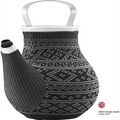Viride exploits advances in artificial lighting to help plants thrive inside.
by: mocoloco, 2017-03-27 20:45:05 UTC
Viride (from the latin green) is a collection of experimental luminaries by Goula / Figuera Studio that brings together two omnipresent elements in the domestic landscape: artificial lighting and plants.

Viride DOS: has two led panels with different degrees of orientation and a wide container for plants with a greater need for soil. The container rotates perpetually at very low speed to ensure all the plants receive the same amount of light. Additionally, Viride Dos integrates an ultrasonic air humidifier which increases air moisture.
Says Goula / Figuera, “Lamps and plants have been found within homes for centuries, but always separately. Plants, in order to live in interiors, have always relied on the need of sun light which enters through the windows, and its amount and quality, has always conditioned the choice of a specific kind of plant.”
Viride DOS
“However, in modern interiors, natural light is not always available, while, at the same time, the advances on artificial lighting today allow to grow vegetables without a single ray of sun.”

Viride DOS
“Viride blends the suggestive capability for transforming interiors of light with the decorative natural beauty of plants in a new typology of object. The collection is composed of three different models each one specially designed for a specific plants’ morphology.”

Viride DOS
“All of them have one or more led panels with a color scheme suitable for interiors and at the same time convenient for the growth of the plants.”

Viride TRES: was conceived for hanging plants, (shown here, Nephentes, a carnivorous plant) has three led panels distributed in a way so the leaves receive light from all directions. When lit, the three led panels rotate continuously at very low speed in a continuous movement that poetically evokes the sunrise and twilight.
“Furthermore, the leds are programmed to turn on and off periodically in order to ensure that each plant receives the most suitable amount of light.”

Viride TRES

Viride TRES

Viride TRES

Viride UNO: with only one static and larger led panel, is specially suited for plants that demand a small amount of substrate, like tillandsias (epiphytes or air plants) which grow without soil, and get water and nutrients from the air.

Viride UNO

Viride UNO
Zero-carbon home generates income by making more energy than it needs
by: Inhabitat , 2017-03-06 09:22:01 UTC
The home of the future could slash your utility bills and generate enough money to help pay the mortgage. UK firm Koru Architects designed and built one such house, named the Lloyd House, that’s effectively zero-carbon and runs entirely on renewable energy. Tucked away on a quiet street in England’s East Sussex, this contemporary home generates more energy than it consumes and even brings in a net income of £2650 per year from solar photovoltaics, solar thermal, and a wood-chip biomass boiler.





















Completed in 2011 as a case study, the Lloyd House is a large and contemporary three-bedroom home that only consumes around half the energy of a typical UK household thanks to its use of passive solar design, energy efficient appliances, effective insulation, and high airtightness. The home was built with mostly natural materials including sustainably sourced timber for the cladding and flooring, zinc roofing, hemp and wood-fiber insulation, recycled glass in the kitchen countertops, and lime-based natural plants. Sedum plants carpet the roof to add an additional layer of insulation and provide habitat to local insects and birds. A 4,700-liter Freewater UK Elite rainwater harvesting system collects rainwater for reuse in irrigation, the washing machine, and the dual-flush toilets.
The Lloyd House produces all the hot water it needs for domestic use and for the underfloor heating with a 6-kilowatt solar thermal system and a 10.5-kilowatt wood-pellet boiler. A twelve 340-kilowatt peak solar array provides around 3800 kilowatt-hour of electricity annually, which is more than it uses thanks to its energy-efficient measures. Excess energy is exported to the grid and, with the help of renewable heat incentive and feed-in-tariff schemes, the home brings in a net annual income of £2650 ($3,300 USD) after bills are subtracted. The house emits 93% less carbon dioxide equivalent than the average UK household.
Related: Colorful wind-powered community in Scotland is everything an eco-village should be
Constructed with passive solar principles, the airtight home is oriented towards the south with large areas of glazing to take advantage of the sun’s heat and natural lighting to reduce energy demand. High-level skylights also flood the interior with natural light. In addition to the three bedrooms, the home comprises a home office, two bathrooms, living room, utility room, open plan kitchen and dining area, garage, and garden. The spacious and comfortable interior is organized into split-levels to make the most of the sloped site. “The house is expected to last around 80 years, and through its generation of clean energy it is expected to offset 41 tonnes of carbon over its life,” write the architects. “Including the replacement of the renewable energy technologies, it would take 48 years to become entirely carbon-neutral.” The project was awarded the RIBA Download Prize 2011 in the category for sustainability and serves as a source of green inspiration for the community.
+ Koru Architects



Comments by our Users
Be the first to write a comment for this item.